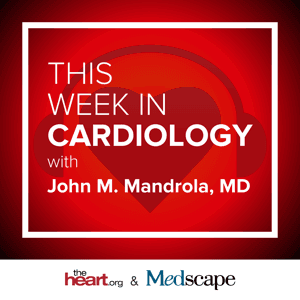CardioNerds (Dr. Kelly Arps, Dr. Naima Maqsood, and Dr. Elizabeth Davis) discuss chronic AF management with Dr. Edmond Cronin. This episode seeks to explore the chronic management of atrial fibrillation (AF) as described by the 2023 ACC/AHA/ACCP/HRS Guideline for the Diagnosis and Management of Atrial Fibrillation: A Report of the American College of Cardiology/American Heart Association Joint Committee on Clinical Practice Guidelines. The discussion covers the different AF classifications, symptomatology, and management including medications and invasive therapies. Importantly, the episode explores current gaps in knowledge and where there is indecision regarding proper treatment course, as in those with heart failure and AF. Our expert, Dr. Cronin, helps elucidate these gaps and apply guideline knowledge to patient scenarios. Audio editing for this episode was performed by CardioNerds intern Dr. Bhavya Shah.
Enjoy this Circulation 2022 Paths to Discovery article to learn about the CardioNerds story, mission, and values.
CardioNerds Atrial Fibrillation Page
CardioNerds Episode Page
CardioNerds Academy
Cardionerds Healy Honor Roll
CardioNerds Journal Club
Subscribe to The Heartbeat Newsletter!
Check out CardioNerds SWAG!
Become a CardioNerds Patron!
Pearls
Review the guidelines- Catheter ablation is a Class I recommendation for select patient groups Appropriately recognize AF stages- preAF conditions, symptomatology, classification system (paroxysmal, persistent, long-standing persistent, permanent) Be familiar with the EAST-AFNET4 trial, as it changed the approach of rate vs rhythm control Understand treatment approaches- lifestyle modifications, management of comorbidities, rate vs rhythm control medications, cardioversion, ablation, pulmonary vein isolation, surgical MAZE Sympathize with patients- understand their treatment goals Notes
Notes: Notes drafted by Dr. Davis.
What are the stages of atrial fibrillation?
What are common symptoms of AF?
What are the current guidelines regarding rhythm control and available options?
How would you monitor for AF recurrence in post-ablation or cardioversion? Is there a role for monitoring in every patient?
What AF burden warrants intervention?
What are some options for antiarrhythmic drugs and their characteristics?
When should AV node ablation (AVNA) be considered?
What are some recommendations for managing atrial fibrillation in the perioperative period?
References
Joglar, J, Chung, M. et al. 2023 ACC/AHA/ACCP/HRS Guideline for the Diagnosis and Management of Atrial Fibrillation: A Report of the American College of Cardiology/American Heart Association Joint Committee on Clinical Practice Guidelines. JACC. 2024 Jan, 83 (1) 109–279. https://doi.org/10.1016/j.jacc.2023.08.017 Fuster F, Rydén L, et al. ACC/AHA/ESC Guidelines for the Management of Patients With Atrial Fibrillation: Executive Summary A Report of the American College of Cardiology/American Heart Association Task Force on Practice Guidelines and the European Society of Cardiology Committee for Practice Guidelines and Policy Conferences (Committee to Develop Guidelines for the Management of Patients With Atrial Fibrillation) Developed in Collaboration With the North American Society of Pacing and Electrophysiology. Circulation. 2001 Oct, 104 (17). https://doi.org/10.1161/circ.104.17.2118 Kirchhof P, Camm A, et al. Early Rhythm-Control Therapy in Patients with Atrial Fibrillation. N Engl J Med. 2020 Aug, 383 (14) 1305-1416. DOI: 10.1056/NEJMoa2019422 Olshansky, B, Rosenfeld, L, Warner, A. et al. The Atrial Fibrillation Follow-up Investigation of Rhythm Management (AFFIRM) study: Approaches to control rate in atrial fibrillation. JACC. 2004 Apr, 43 (7) 1201–1208.https://doi.org/10.1016/j.jacc.2003.11.032 Whitlock R, Belley-Cote E, et al. Left Atrial Appendage Occlusion during Cardiac Surgery to Prevent Stroke. N Engl J Med. 2021 May, 384 (22) 2081-2091. DOI: 10.1056/NEJMoa2101897 Kirchhof P, Toennis T, et al. Anticoagulation with Edoxaban in Patients with Atrial High-Rate Episodes. N Engl J Med. 2023 Aug, 389 (13) 1167-1179. DOI: 10.1056/NEJMoa2303062 Healey J, Lopes R, et al. Apixaban for Stroke Prevention in Subclinical Atrial Fibrillation. N Engl J Med. 2023 Nov, 390 (2) 107-117. DOI: 10.1056/NEJMoa2310234 Roy D, Talajic M, et al. Rhythm Control versus Rate Control for Atrial Fibrillation and Heart Failure. N Engl J Med. 2008 Jun, 358 (25) 2667-2677. DOI: 10.1056/NEJMoa0708789 Gillinov A, Bagiella E, et al. Rate Control versus Rhythm Control for Atrial Fibrillation after Cardiac Surgery. N Engl J Med. 2016 Mar, 374 (20) 1911-1921. DOI: 10.1056/NEJMoa1602002 



































